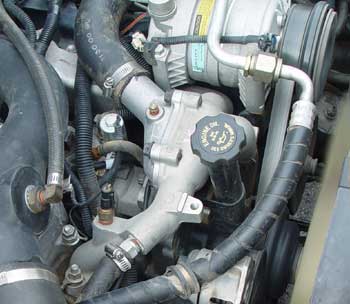Change Your Thermostats & Check your Cooling Fan
Change Antifreeze . Diesel Coolant . Cooling Stack Clean . Intercooler . Cooling System
Updated August 2, 2006

These are all the numbers off the Delco thermostat box GR .1.246 75G01 131-103
This GM part number is on the actual thermostat 12559336 - $31.39 each (12/04)
The Hummer dealer wanted $51.00 each. At the Chevy dealer we tried a 1999 Chevy 1 ton truck with a diesel and it came up with the 6.5L turbo diesel. I went to Autozone to check the thermostat that they had. There was no rubber or the 1" of brass with rubber around it on the bottom. I took a pass on it.
If your engine doesn't warm up like it used to there is a good chance it's the thermostats. In fact there were a bunch of bad thermostats in the supply chain back in 2000. I replaced my stats once and had to get more because the first replacements were defective. If changing the stats doesn't fix your problem then read the article on cleaning your cooling stack and cracked blocks. If you haven't, this is a good time to flush your cooling system and replace the antifreeze. Don't forget to check your radiator cap. It can cause all kinds of cooling system problems. The cap seals the cooling system and determines the cooling system pressure.
 What I do is open the bottom drain petcock, remove the radiator cap and drain about a gallon of antifreeze. This will ensure that all the antifreeze is drained from the upper hoses and the thermostat area so it doesn't spill all over the place when you open the housing up. The picture on the left is from the AMG shop manual.
What I do is open the bottom drain petcock, remove the radiator cap and drain about a gallon of antifreeze. This will ensure that all the antifreeze is drained from the upper hoses and the thermostat area so it doesn't spill all over the place when you open the housing up. The picture on the left is from the AMG shop manual.

Undo the upper radiator hose clamp and pull the hose off of the thermostat housing. Remove the 4 bolts holding the thermostat cover on the housing. This will expose the stats.
One of the bolts is a real pain to get off. I was able to get on the bolt by running a long extension from the back of the engine.

Just pull the thermostats out, replace them and bolt it back up. The only seal that is vital is the housing cover so it won't leak coolant.
Look at a thermostat carefully and you'll see a small bleed hole, which would pass more coolant than any leak around the edge would. Why the small bleed hole? This allows you to bleed the air from the cooling system without having to run the engine up to temperature. This minimizes the danger that low coolant in the heads might cause spot overheating (a problem with aluminum heads) The bleed hole will pass enough air that you can usually fully fill the cooling system if you go slowly.

The picture on the left shows 2 bad thermostats that I removed from my truck. Most of the time you won't be able to see any physical marks to indicate they are bad.
Put the radiator hose back on the housing and fill the truck back up with antifreeze. Follow the instructions given in the change antifreeze article to refill and purge out the air.
Engine Doesn't Reach Temperature
I live at 9000' elevation & drive down 5,800' elevation in only 9 miles. Because it's downhill, cold outside & the engine is basically at idle most of the way, the thermostat stays at 160-170 degrees the whole way. Driving home, the truck stays at 165 until I go up Lookout Mountain & then it climbs to 195. My temp gauge will be low in cold weather whenever the engine isn't working very hard, it will even dip down below 195 when going down a long hill. When I'm on the freeway going 55-65mph on flat road, the temp will always rise to 195 after ~10 miles no matter how cold it is.
That's normal. My truck did the same thing coming down from the mountains on I70 toward Denver. When you crest the hill the stats are wide open. When you start down there is no load on the engine and the water pump is still circulating coolant so the engine cools off very fast, faster then the time it takes for the stats to close down. That's why the engine temp drops to 160. You are still going down hill once the stats are closed so the engine isn't producing much heat while air at highway speeds is still cooling off the radiator and engine. This keeps the engine from reaching 195 again. Diesels are more efficient then gas engines and don't produce as much latent heat. That's why it's difficult to get a diesel up to temperature while it's idling.
It is more difficult to test the thermostat capability (and this can fail). You need to apply heat to the sensor element (which is external at the center of the clutch) and be able to monitor the temperature applied. There is a point where the fan clutch will begin to lock up. However with the Hummer it is virtually impossible to get at the front of the clutch because of the fan shroud.
Bottom line: cold, some drag, not free spinning, not locked it's probably fine.

